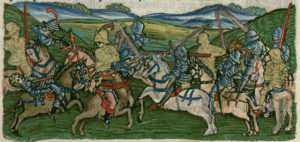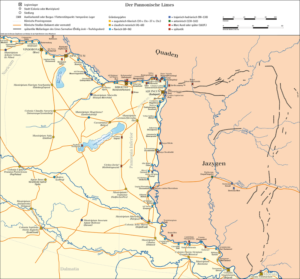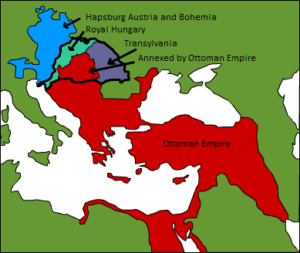The Hungarian-Croatian-Transylvanian
Borderland
Castles in the Kingdom of Hungary before the Ottoman threat
Let me tell you a few words about the predecessors of the Borderland castles, according to the research of Horváth Richárd–Nagy Béla (Research Centre for the Humanities Institute of History). Here is the Institute’s map indicating the castles until 1457:

In the medieval Kingdom of Hungary, the construction of castles essentially coincided with the establishment of the state. Already in the first half of the 11th century, perhaps even a little earlier, the so-called wood and earth “castles of the Comes” secured the power of the Árpád dynasty in the Carpathian Basin. One of the most spectacular examples of the latter fortifications is the “earth castle” of Sabolch, which can still be seen today.

As the composition of society changed during the Árpád period, and especially from the end of the 12th century, there was a significant change in the land tenure system (i.e. the increasing number of small and large private estates at the expense of the royal estates), private castles (called castrum in Latin terminology) appeared more and more. The increase in the number of private castles was further accelerated by conflicts and internal struggles within the royal house (e.g. the conflicts and struggles between András II and Béla IV or Béla IV and his son King István the Younger in the 1260s) and shock of the Mongol invasion. (My note: King Béla IV launched a large castle construction project after the invasion.) At the same time, the legal principle that castles could be built in Hungary only with the permission of the monarch was never abolished, or at most weakened.

This large number of private castles allowed many to defy even royal power (see oligarchs) at the end of the Árpád era and the beginning of the Angevin era, but only for a time. Charles I (King Károly Rőbert) regained control of the kingdom through hard fighting (1312-1321) and castle wars, and kept most of the fortresses he had acquired in royal hands (giving them only temporarily to his supporters, the basis of the honor system), some of which were destroyed. This situation may have contributed in part to the existence of a very strong royal power in the Angevin era.

The situation changed again with the accession of Zsigmond of Luxembourg (1387-1437). The new king needed new supporters, so a large number of castles (and their associated estates, customs, manors, and rights, collectively known as “manors”) were taken over in a very short time (c. 1387-1395). It was during this period that the large family estates, which were so important in the history of the late Middle Ages, such as those of the Perényi, Újlaki, or Garai families, came into being.

The Zsigmond era also brought another change of centuries’ importance. In the 1390s a new type of fortress appeared in the documents, the “castellum” (consistently called castellum in Latin). They were generally smaller than the classical castles, most of them were not separated from the inhabited settlements like the hilltop fortresses, but there was certainly no consistent social separation behind them. A “manor” could be owned by the largest landowners in the country, by clergymen, or even by a county nobility with a single manor.

The map above shows the structure of the castle and manor network of the Kingdom of Hungary in the mid-15th century, by which time this “system” had reached its heyday. It is also an important snapshot because it is from this period that the Ottoman Empire began its increasingly large and systematic attacks on the southern borders (remember, with the fall of Constantinople in 1453, the elimination of the remaining Balkan states of Serbia and Bosnia was only a matter of time). It was this group of fortresses, most of them along the southern borders, that took up the fight. Their geographical location and distribution also clearly show why the Transdanubian and northeastern areas were the “second” outposts after the Ottoman breakthrough in 1526.
The Borderland and the Ottoman threat
Professor Perjés Géza was comparing the ancient Romans’ Limes and the chain of castles on the Hungarian Frontier…

Comparing the two systems, the Hungarian historian Perjés Géza concluded that the Hungarian defense system in the 16th and 17th centuries had a more difficult task than the Roman system in the 2nd century.
(My note: not that the two systems can be historically compared in a sense of which was “better”. I think the professor could not find another equally long line of defense because the Borderland was quite “incomparable”).
Professor Perjés says:
„Let me tell you some data to prove why the defense of the Roman Limes against the barbarians was a tough job.
The length of the Limes built against the Germans used to be 500 km long in the 1st-2nd century A.D.
This line was guarded by 15-25,000 auxiliary forces and 8 legions which meant 45-55,000 professional soldiers. Altogether there were about 70,000 on guard.

The length of the Hungarian Borderland’s chain of castles was about 1,200 km from the Adriatic Sea to the Tisza River.
(My note: the Transylvanian part of the Borderland is not even included but it was part of this frontier, nevertheless, with a similar small war going on, even though Transylvania was regarded as a (semi)-vassal of the Ottoman Empire.)
In the Frontier castles, there were 15-20,000 settled border guards and Hajdu soldiers. Additionally, the local lords had about 20,000 settled warriors. The king paid only 15-20,000 soldiers in the Borderland castles. (My note: half of the Borderland castles were owned by the local noblemen.)
So, there were altogether about 60,000 soldiers available.
If we regard the rates, 140 Roman soldiers were guarding one kilometer while only 50 soldiers were guarding the same distance in the Borderland. This rate is even more disadvantageous if we consider that the soldiers in the 8 legions were professional soldiers while there were usually no such trained soldiers taking part in guarding the Borderland in Hungary.

Besides, the Roman Limes was a structure built of continuous walls and trenches with ditches and watchtowers while the castles and the watchtowers of the Borderland were not connected like this.”
How could the defense be effective enough for so many years? The system was built at the beginning of the 15th century and we know how successful it was if we take a look at the Siege of Nándorfehérvár (Belgrade) in 1456 when the assault of the sultan who had taken Constantinapolis was repelled. After the collapse of the first Borderland system in the south after 1522, and in earnest, after 1541, the chain of „frontier houses” (forts) worked very successfully until 1699.

Why were they better than the structures of the ancient Limes which had been guarded by more numerous and more experienced Roman troops? There was a saying among the warriors of the Valiant Order, the defenders of the Borderland: „A castle can be defended only in the field.”According to Perjés Géza, the Ottoman attackers have always been in a better position as they could concentrate a great number of soldiers at any point in the defense line. At the same time, the defenders were always scattered in several castles and as a result of this, they were weaker. He says that constant defensive warfare is doomed and it can be only successful if the defenders keep attacking the enemy. (Please note, that I am using the Oriental name order for Hungarians where family names come first.)

In the Hungarian and Croatian Borderland castles, the rate of cavalry and infantry was 1:1 because speed and mobility were the most important elements of their tactics, not to mention their very high quality of martial arts with their weapons.
According to Klaniczay Tibor, this 16-17th-century Borderland defense system can be considered as a „Hungaricum”, an outstanding structure in Europe in its age. He adds, that the existence of the Valiant Order is also a special development of Hungarian history: their society is quite matchless in contemporary Europe, although there were similar societies of soldiers facing the Ottomans or the Crimean Tatars on the edges of Eastern Europe.
As for Poland and Ukraine, the defensive fights were rather far away from the heart of the country, a bit isolated from the entire society while the Hungarian Borderland cut the country into several parts in the middle of the kingdom. The whole society felt the presence of the Ottoman peril.
My note: there were some desperate Habsburg plans in the 1570s that wanted to scorch the land and destroy the whole frontier zone just to make it harder to pass for the Ottoman raiders who sometimes rode as far as the northern fringe of Royal Hungary. Luckily, the Hungarian Estates dissuaded the monarch from this plan. The zone between the Turks and the Hungarians was very wide and many people lived there who paid taxes to both sides.
Since Roman times, Hungary, more particularly the Bend of the Danube has always been a frequently visited gate where the barbarians and the other Eastern tribes arrived to enter and invade the western lands. But it was just a destination: the „highway of nations” was the steppes of South Ukraine and the Moldavian lands even in the 16th century.
There was a wide area that isolated this highway from the Ottoman Empire. It was uninhabited and the Ottomans wanted to settle several Tatar tribes there to extend their range of influence. It can be said that this area became a kind of political and cultural border as well.
Historians toy with the idea that a lengthy Frontier could be drawn on the map, all along the borders of Eastern Europe which was surrounding and defending entire Central Europe.
The Hungarian Borderland was connected to a similar Croatian system called „čosjstvo i junštvo” and there was a similar Frontier in Poland, the „swiat kreswy”.
On the Eastern fringe of Europe, on the steppes, new settlements were established in the 1570s. These settlements were located very far away from each other but many of them became agricultural fortified towns where the population was increasing, due to the Tatar and Nogai settlers and we haven’t spoken of the Cossacks yet…
In Royal Hungary, we can see clearly how the Habsburg administration and the ruler relied on the support of the Hungarian Estates due to the constant Ottoman threat. It would have been insane of the Habsburgs to bring the war to Austria.

And vice-versa: the Hungarian lords could not have defended the remaining kingdom on their own, without the financial and military aid of the Habsburg Empire. At the same time, the well-built Borderland system was effectively blocking the daily waves of Ottoman attacks that wanted badly to plunder and raid the rich Austrian lands. However, the huge Ottoman army was always lacking trained artillery engineers, and many times they had to rely on French engineers when a major siege took place. We have a short film about the siege wars in Hungary, created by the Hungarian Military Museum and Institute. Why making ditches was useful during a siege in the 16th century? Why were siege ladders almost useless? What did siege warfare look like in these times? You can view it here:
https://www.youtube.com/watch?v=kw4VUAXFUsY
It was the reason why the Habsburgs mostly allowed the survival of the Hungarian institutions’ administration of the Estates. The Hungarian Diet was working, the system of Counties was operating, and the main traditional ranks were granted to Hungarians (like the rank of Palatine who was in charge of the country in the absence of the king).
In theory, the Hungarian Chancellery and the Hungarian Chamber were independent bodies but in fact, they were instructed by the central office of the king from Vienna. The Hungarian Estates were insisting on keeping the old Hungarian constitution and their privileges intact but they had to cede the financial, military, and foreign political affairs to the Habsburgs in exchange for organizing the defense together against the Ottoman Empire.
Moreover, very few of the Estates were given high posts in the central governing institutions of the king.”

According to Professor Perjés, major changes took place in the Hungarian defense system after 1526:
„The most profound changes happened in the administration of military issues and technical questions. Compared to the late medieval age, the situation of military command at the end of the 16th century has significantly changed.
This change was observed in many European war zones but it was strikingly visible in Hungary as it was becoming one of the greatest battlefields of Europe.
For example, we can trace this change in the newly formed northern castle system’s 100-120 forts whereas there were three times more soldiers serving in the second part of the 16th century than in the southern castle chain before 1526. There were about 20,000 men paid by the king while there were just 7-8,000 soldiers before 1526.
The number of this standing army is remarkably high, even by contemporary European standards. Neither the Spanish Habsburgs, the Venetians in Dalmatia, the Polish nor the 17th-century Russians kept together such a large army against the Ottomans for such a long time, not to mention the length of the castle chain.”

However, we haven’t even talked about the Hungarian Székely border guards of Transylvania who could be mobilized in case of danger. Their number was between 40 and 20 thousand warriors. You can read more about them here:
https://www.hungarianottomanwars.com/essays/who-were-the-szekelys/
(Source: Szerecz Miklós, Klaniczay Tibor, and Perjés Géza, translation and a few additions: Szántai Gábor)
Dear Readers, I can only make this content available through small donations or by selling my books or T-shirts.
If you like my writings, please feel free to support me with a coffee here:
You can check out my books on Amazon or Draft2Digital, they are available in hardcover, paperback, or ebook:
https://www.amazon.com/dp/198020490X
or at https://books2read.com/b/boYd81


My work can also be followed and supported on Patreon: Become a Patron!http://Become a Patron!



